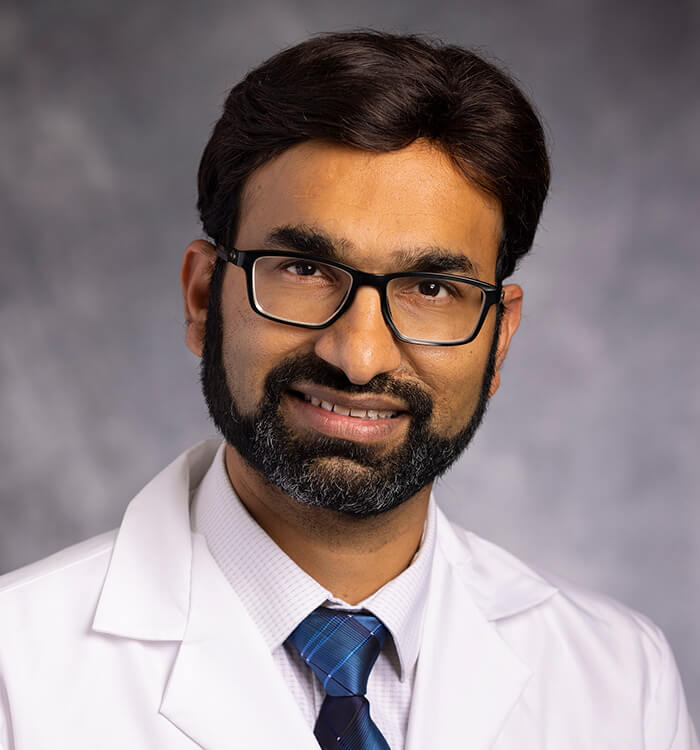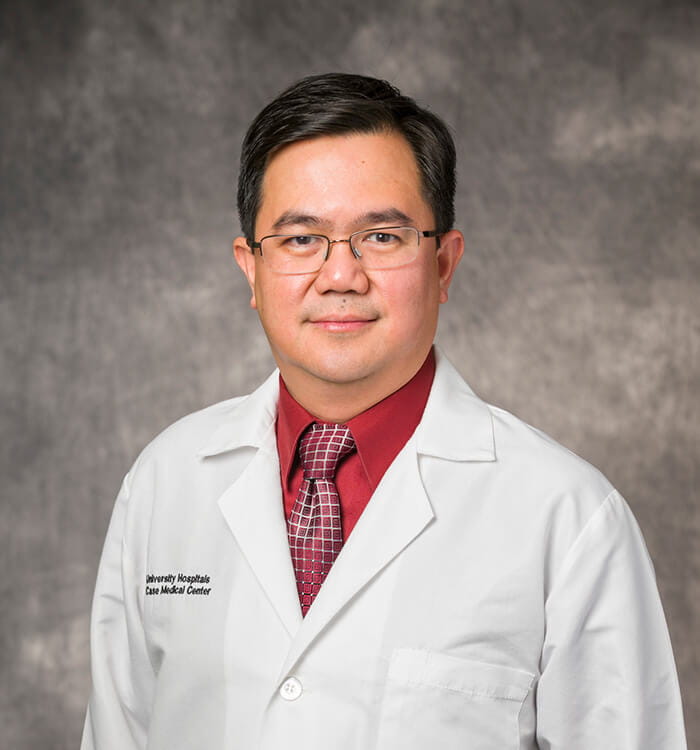Minimally Invasive Spine Surgery and Multidisciplinary Care
January 03, 2017
UH Neurological Institute - January 2017
 Manish K. Kasliwal, MD
Manish K. Kasliwal, MD Edward Capulong, MD
Edward Capulong, MDMinimally invasive spine surgery (MISS) is regularly sought after by patients because it enables them to recover and return to their routine more quickly. Neurosurgeon Manish K. Kasliwal, MD, Director, Minimally Invasive Spine Surgery, University Hospitals Cleveland Medical Center, leads the way in this expanding surgical area within spine surgery.
There has been an unprecedented growth in the field of minimally invasive surgery throughout medicine, paralleling the technological advancements and decreased related morbidity compared with traditional open surgical approaches, Dr. Kasliwal said. In fact, minimally invasive procedures are routinely performed in gynecology, urology, oncology and other specialties. Spine surgery remains no exception, where the majority of routine surgeries now can be performed via minimally invasive techniques rather than traditional open techniques, with additional advantages such as better cosmesis, decreased infection, reduced blood loss, reduced post-operative pain and shorter hospital stays. These advantages ultimately translate into wider patient acceptance. Minimally invasive techniques use one or more incisions of about an inch or less to treat routine spinal pathologies that in the past required larger incisions and significant muscular dissections.
“There has been an exponential growth in technology in the past few years that now allows spine surgeons to perform a number of procedures using minimally invasive approaches,” Dr. Kasliwal says. Many routine spinal surgeries and about one third or more of more complex cases can be performed with the use of minimally invasive techniques. Although there is great interest in minimally invasive procedures among neurosurgeons, they can be technically challenging. Dr. Kasliwal uses his experience and expertise to perform procedures such as cervical foraminotomy and discectomy for selected cases of cervical disc herniation, thoracic discectomy and fusions, lumbar discectomy, lumbar laminectomy, and lumbar fusions via minimally invasive techniques on a routine basis. Apart from these, he also specializes in treating a subset of adult scoliosis patients and multilevel lumbar fusion via a minimally invasive approach.
Although a majority of patients in need of spinal surgery may qualify for minimally invasive spine procedures, there are some exceptions. Patients with multiple previous surgeries, especially with prior instrumentation such as screws and rods, are challenging regardless of the approach and usually are still best suited for traditional open approaches. Similarly, for very advanced adult scoliosis or spinal deformity that requires major spinal reconstruction, open approaches are still preferable. Another limitation is a surgery requiring a longer fusion for conditions such as scoliosis extending from the upper back to lower back. “Other than that, it’s on a case-by-case basis,” Dr. Kasliwal says. A couple of areas where MISS has significant advantages include obese patients and the elderly population.
Minimally invasive spine surgery is a tissue-sparing approach and can be performed using endoscopes or tubular dilators and retractors, often with the use of adjunctive magnification (loupes or microscope) with use of either conventional or specialized surgical instruments. It typically involves docking 18 mm to 26 mm tubular retractors over a series of dilators that go between the muscle fibers rather than cutting them, either from the back or side of the spine. This provides exposure to the exact site of pathology and allows spine surgeons to decompress the nerve roots and spinal cord and insert intervertebral cages and instrumentation including screws and rods through this narrow but adequate portals. Surgeons now have the ability to apply these principles to a vast range of pathologies extending from routine degenerative conditions such as disc herniation and stenosis to advanced scoliosis, trauma and even infectious and oncological cases.
A Quicker Recovery, Fewer Side Effects
Patients who have MISS typically go home either the same day or in one to two days depending on the pathology versus two to four days—or sometimes longer—with an open approach, Dr. Kasliwal says. Because the collateral damage to the normal tissues is less, minimally invasive approaches also allow faster recovery and an earlier return to routine activities.
There is often a learning curve for programs and surgeons to adopt a less invasive approach. “It takes some time to get proficient, but once mastered, the overall operative duration becomes the same and even shorter than traditional open approaches with the added advantages of minimal invasive approach as mentioned above,” Dr. Kasliwal says. A number of studies have shown that the clinical outcome following MISS is equivalent to and often rivals that of traditional open approaches, minus the morbidity associated with the latter.
As with any surgery, there are still some risks associated with a less invasive approach. These can include infection, blood loss, nerve damage, pain, and blood clots. However, these risks are lower than with open surgery.
More patients now request minimally invasive spinal surgery due to its quick recovery and fewer side effects. Although a significant number of patients qualify for MISS, not everyone does. The importance of appropriate case selection and judicious application of MISS techniques to achieve overall clinical objectives cannot be overemphasized, Dr. Kasliwal says.
A Leader in Treating Spinal Disorders
The Comprehensive Spine Center focuses on techniques that improve results, reduce pain, and accelerate recovery. The center’s advanced procedures include:
- Endoscopic and minimally invasive spinal neurosurgery
- Functional and restorative spinal neurosurgery
- Image-guided surgery
- Laparoscopic fusions and other fusion techniques
- Microsurgery
- Microvascular surgery
- Minimally invasive neurosurgery
- Revision spine surgery
- Spinal decompression including laminectomy and discectomy
- Spinal implants
- Multidisciplinary Approach for Spinal Care: Re-defining Back Pain Management
To further ensure excellent patient care, University Hospitals’ Comprehensive Spine Center –Medical Spine Section regularly provides nonsurgical multidisciplinary care for patients.
Edwin Capulong, MD, with subspecialty training in Medical Spine and Pain Management, heads the Medical Spine Section of the Neurological Institute, under the Department of Neurosurgery. Many of the physicians who participate in medical spine specialties include pain management, rheumatology, neurology, physical medicine and rehabilitation, and primary care physicians, among others.
These physicians view spinal problems in terms of how they affect overall health and lifestyle. With a multi-disciplinary approach, it has been proven to increase quality of care and improve result, with the goal of recovery and return to full functional status.
Our comprehensive care includes the following:
- The first tier in the nonsurgical therapeutic concept in management of back pain includes osteopathic/chiropractic manipulation, acupuncture, in addition to physical therapy and medication management (mostly non-opioid therapies).
- The second tier includes pain interventional procedures, which include epidural or facet block, aka a “nerve block.”
As part of the multidisciplinary approach, our surgical referral system is as strong and cohesive. One of the roles of Medical Spine is to facilitate referral, and if there is need for same-day medical surgical evaluation, this can be done expeditiously through the regular referral system or through a combined medical–surgical clinic. This collaboration has been invaluable for some cases where a significant neurologic deficit(s), which includes weakness, occurs in the setting of a positive diagnostic tests (in this case, MRI).
As part of “system modelling” to create a better health care delivery, the Department of Neurosurgery, in partnership with Department of Orthopedics, started the critical collaboration to create the enterprise-wide Spine Institute.
On the medical side, we are spearheading a more collaborative and structured therapy by including physical therapy and Integrative medicine, to further explore and effectively utilize manual and physical therapy as one of the main treatments of spinal pain, Dr. Capulong says. As part of the continuum of care, adding pain management, occupational medicine, sports medicine and primary care physicians as stakeholders creates an integral part that will create a 360-degree evaluation—that is, covering degenerative, work and sports-related injuries.
Most importantly, the psychiatry-based chronic pain program and addiction medicine can provide a more comprehensive care in patients with significant psychosocial stressors, which is a critical part of pain care.
Because of University Hospitals’ multidisciplinary approach, the Spine Division has been designated a Center of Excellence by the National Spine Institute—one of only 20 in the United States.
To Contact the Dr. Kasliwal email: Manish.Kasliwal@UHhospitals.org.


